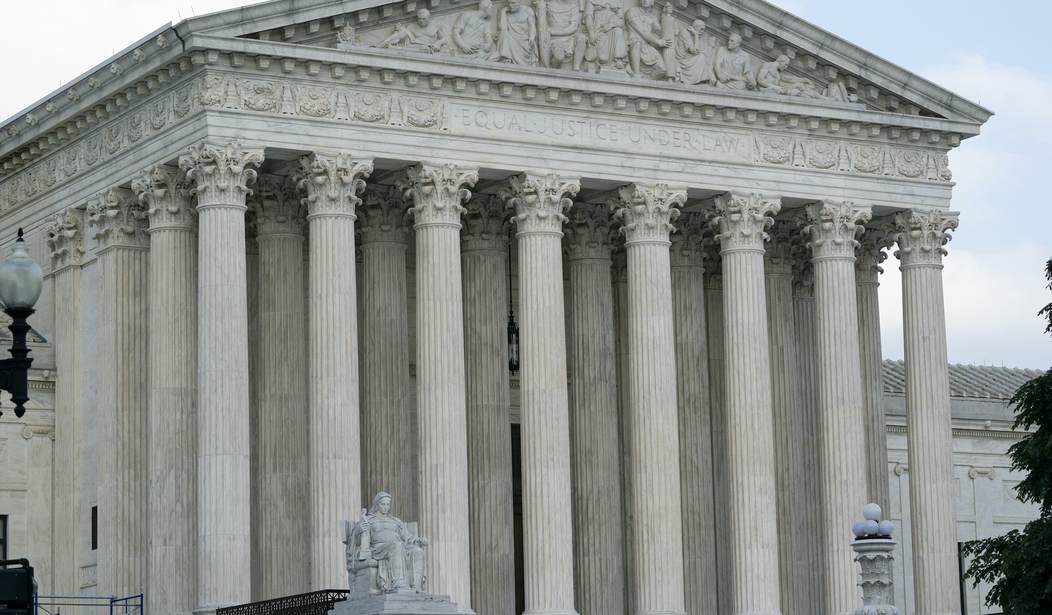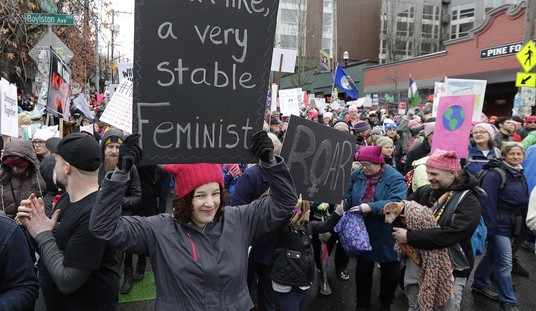Things are starting to pick up steam in the (for all practical purposes) closing weeks of the Supreme Court's 2023 term. The court added Friday as a decision day this week and knocked out three more opinions. We're starting to see less unanimity in these later decisions, with two 6-3 splits and one 5-4 split in this latest batch.
One of the more anticipated decisions was among them, in Garland v. Cargill, regarding the ATF's bump stock ban implemented in 2018 following the horrific Harvest Music Festival shooting in Las Vegas in 2017.
Supreme Court Delivers Major Gun Rights Victory With Bump Stock Decision
Then, too, there was a welcome ruling on deportation notification requirements on the illegal immigration front in Campos-Chaves v. Garland.
Supreme Court Rules That Technical Flaws in Paperwork Can't Stop a Perfectly Good Deportation Order
So, to the skinny on this latest three:
June 14, 2024 Decisions
Date: June 14, 2014
Author: Thomas
Split: 6-3
Dissent: Sotomayor, Kagan, Jackson
Appeal From: Fifth Circuit
Basic Facts:
The National Firearms Act of 1934 defines a “machinegun” as “any weapon which shoots, is designed to shoot, or can be readily restored to shoot, automatically more than one shot, without manual reloading, by a single function of the trigger.” 26 U. S. C. §5845(b). With a machinegun, a shooter can fire multiple times, or even continuously, by engaging the trigger only once. This capability distinguishes a machinegun from a semiautomatic firearm. With a semiautomatic firearm, the shooter can fire only one time by engaging the trigger. Using a technique called bump firing, shooters can fire semiautomatic firearms at rates approaching those of some machineguns. A shooter who bump fires a rifle uses the firearm’s recoil to help rapidly manipulate the trigger. Although bump firing does not require any additional equipment, a “bump stock” is an accessory designed to make the technique easier. A bump stock does not alter the basic mechanics of bump firing, and the trigger still must be released and reengaged to fire each additional shot.
For many years, the Bureau of Alcohol, Tobacco, Firearms and Explosives (ATF) consistently took the position that semiautomatic rifles equipped with bump stocks were not machineguns under §5845(b). ATF abruptly changed course when a gunman using semiautomatic rifles equipped with bump stocks fired hundreds of rounds into a crowd in Las Vegas, Nevada, killing 58 people and wounding over 500 more. ATF subsequently proposed a rule that would repudiate its previous guidance and amend its regulations to “clarify” that bump stocks are machineguns. 83 Fed. Reg. 13442. ATF’s Rule ordered owners of bump stocks either to destroy or surrender them to ATF to avoid criminal prosecution.
Michael Cargill surrendered two bump stocks to ATF under protest, then filed suit to challenge the Rule under the Administrative Procedure Act. As relevant, Cargill alleged that ATF lacked statutory authority to promulgate the Rule because bump stocks are not “machinegun[s]” as defined in §5845(b). After a bench trial, the District Court entered judgment for ATF. The Fifth Circuit initially affirmed, but reversed after rehearing en banc. A majority agreed that §5845(b) is ambiguous as to whether a semiautomatic rifle equipped with a bump stock fits the statutory definition of a machinegun and resolved that ambiguity in Cargill’s favor.
Whether a bump stock device is a "machinegun" as defined in 26 U.S.C. 5845(b) because it is designed and intended for use in converting a rifle into a machinegun, i.e., into a weapon that fires "automatically more than one shot * * * by a single function of the trigger."
Holding: Affirmed.
ATF exceeded its statutory authority by issuing a Rule that classifies a bump stock as a “machinegun” under §5845(b).
Skinny: Bump stocks aren't prohibited by the National Firearms Act.
An added note: As Alito rightly points out in his concurrence, Congress might not see a practical difference between a machine gun and an semiautomatic rifle outfitted with a bump stock, but if so, then it's incumbent on them to amend the statute accordingly, not the ATF.
Also, I'm no firearms expert, but Thomas' description of the mechanics of the firing cycle for a semiautomatic rifle — and the accompanying illustrations and animation — was superbly clear and concise.
Campos-Chaves v. Garland (consolidated with Garland v. Singh and Garland v. Mendez-Colin)
Date: June 14, 2024
Author: Alito
Split: 5-4
Dissent: Jackson, Sotomayor, Kagan, Gorsuch
Appeal From: Fifth Circuit
Basic Facts:
To initiate the removal of an alien from the United States who is either “inadmissible” under 8 U. S. C. §1182 or “deportable” under §1227, the Federal Government must provide the alien with “written notice” of the proceedings. §§1229(a)(1), (2). Two types of “written notice” are described in paragraphs (1) and (2) of §1229(a): Paragraph (1) provides that the alien be given a written “ ‘notice to appear,’ ” or NTA, which must set out, among other things, “[t]he time and place at which the proceedings will be held.” Paragraph (2) states that “in the case of any change or postponement in the time and place of such proceedings,” the agency must provide “a written notice” specifying “the new time or place of the proceedings” and “the consequences” of failing to attend. An alien who fails to attend a hearing despite receiving notice “shall be ordered removed in absentia” if the Government “establishes by clear, unequivocal, and convincing evidence” that “the written notice” was provided and that “the alien is removable.” §1229a(b)(5)(A). Three scenarios permit the rescinding of an in absentia removal order, one of which is when an alien “demonstrates that [he] did not receive notice in accordance with paragraph (1) or (2)” of §1229(a). §1229a(b)(5)(C)(ii).
In these consolidated cases (one from the Fifth Circuit, and two from the Ninth), aliens Esmelis Campos-Chaves, Varinder Singh, and Raul Daniel Mendez-Colín, each moved to rescind his in absentia order of removal on the ground that he did not receive proper notice of the removal hearing. In each case, the Government provided an initial NTA, but the NTA did not specify the time and place of the removal hearing. Eventually, the Government provided each alien with a notice of hearing under §1229(a)(2) which set out the specific time and place of the removal hearing. None of the aliens showed up for his hearing, and each was ordered removed in absentia by an Immigration Judge. Each then sought to rescind the removal order, arguing that he did not receive a proper NTA under §1229(a)(1). The Fifth Circuit considered and denied one of the petitions, but the Ninth Circuit granted the other two.
If the government serves an initial notice document that does not include the "time and place" of proceedings, followed by an additional document containing that information, has the government provided notice "required under" and "in accordance with para- graph (1) or (2) of section 1229(a)" such that an immigration court must enter a removal order in absentia and deny a noncitizen's request to rescind that order?
Holding: Affirmed (Fifth Circuit); reversed/vacated and remanded (Ninth Circuit).
Because each of the aliens in this case received a proper §1229(a)(2) notice for the hearings they missed and at which they were ordered removed, they cannot seek rescission of their in absentia removal orders on the basis of defective notice under §1229a(b)(5)(C)(ii).
Skinny: As long as an illegal alien is provided a notice with the time and place of their removal hearing, they can be ordered deported if they fail to show for it.
Office of the United States Trustee v. John Q. Hammons Fall 2006, L.L.C.
Date: June 14, 2024
Author: Jackson
Split: 6-3
Dissent: Gorsuch, Thomas, Barrett
Appeal From: 10th Circuit
Basic Facts:
Two Terms ago, in Siegel v. Fitzgerald, 596 U. S. 464, the Court held that a statute violated the Bankruptcy Clause’s uniformity requirement because it permitted different fees for Chapter 11 debtors depending on the district where their case was filed. In this case, the Court is asked to determine the appropriate remedy for that constitutional violation. As noted in Siegel, there are three options: (1) refund fees for the thousands of debtors charged higher fees in districts administered by the U. S. Trustee Program, (2) retroactively extract higher fees from the small number of debtors charged lower fees in districts administered by the Bankruptcy Administrator Program, or (3) require only prospective fee parity. See id., at 480.
As in Siegel, this case arises from a case filed in a U. S. Trustee district. In 2016, 76 legal entities filed for Chapter 11 bankruptcy in the District of Kansas. In 2018, under the amended fee statute the Court later found unconstitutional in Siegel, the debtors began paying higher fees than they would have if their case had been filed in a Bankruptcy Administrator district. In 2020, the debtors challenged the constitutionality of those fees. The Bankruptcy Court found no constitutional violation, but the Tenth Circuit, anticipating Siegel, reversed. To remedy the constitutional violation, the Tenth Circuit ordered a refund of the debtors’ quarterly fees to the extent they exceeded the lower fees paid in the Bankruptcy Administrator districts. This Court vacated that judgment and remanded the case in light of Siegel, and the Tenth Circuit reinstated its original opinion without alteration.
Whether the appropriate remedy for the constitutional uniformity violation found by this Court in Siegel, supra, is to require the United States Trustee to grant retrospective refunds of the increased fees paid by debtors in United States Trustee districts during the period of disuniformity, or is instead either to deem sufficient the prospective remedy adopted by Congress or to require the collection of additional fees from a much smaller number of debtors in Bankruptcy Administrator districts.
Holding: Reversed and remanded.
Prospective parity is the appropriate remedy for the short-lived and small disparity created by the fee statute held unconstitutional in Siegel.
Skinny: Another version of "The government gets the dough." Basically, there was a problem with different fees for different bankruptcy districts. The court fixed it going forward. The debtors who were forced to pay higher fees before the fix are SOL.
You can check out prior installments of The Skinny on SCOTUS series, here.















Join the conversation as a VIP Member